Rome, Wasn't built in a day
"You and me, were meant to be,
Walking free, in harmony,
One fine day, we'll fly away,
Don't you know that Rome wasn't built in a day,
Hey hey hey.
In this day and age it's so easy to stress,
'Cause people act strange and you can never second guess,
In order to love, child, we got to be strong,
I'm caught in the cross fire,
Why can't we get a long.
'Cause you and me, were meant to be,
Walking free, in harmony,
One fine day, we'll fly away,
Don't you know that Rome wasn't built in a day,
hey hey hey" Morcheeba

Titian's depiction of Venus, Ufizzi Gallery, Florence
Italy, a country filled with history, beauty and delicious food is a place well worth visiting. It has so so so much to see and explore that I would highly recommend minimum 2 weeks if not longer to experience both North and South Italy. I had with me 8 days and decided to venture up north, keeping south of Italy for when I visit next.
A possible itinerary;
-
Rome - 3 days
-
Florence - 1 day
-
Venice - 1 day
-
Pisa - ½ day
-
La Spezia - & Cinque Terre (North Coast of Italy) - 2 days

Gelato at its best
Rome
Things to explore;
-
Heart of Rome
- Campio de Flores
- Piazza Navona
- Trevi Foundation
- Spanish Steps
- Pantheon
-
Walk the Appian Way
-
Tour Vatican City & Sistine Chapel
-
Colosseum
-
Arch of Constantine
-
Roman Forum
-
Palentine Hill
-
Aventino Hill
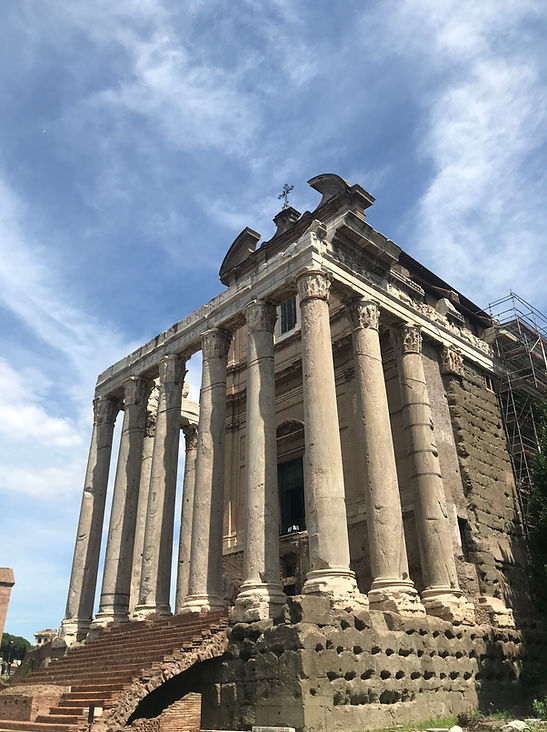
Roman Forum




$1000 per person
14
days
07/16/18-07/29/18
Getting There
Flight
-
Duration: 8 hours
-
Airline: Norwegian
-
Cost: $250 one way direct
Stay
Rome
-
Airbnb: $79 per night
-
Location: Right next to the Colosseum
-
Rating: 4.5 out of 5
Florence
-
Hotel Relais Modern: $75 per night for 2 people
-
Location: 0.5 kilometres from the city center
-
Rating: 4.5 out of 5
La Spezia
-
La Cassa Delle Acciughe: $86 per night for 2 people
-
Location: 10 minute walk from the train station, from where you can get a train to the Cinque Terre villages
-
Rating: 4.5 out of 5
Food
-
Typical Italian: Carbonara, Amatriciana, Cacio e Pepe, Abbacchio, Supplì, Fried Stockfish
Local Travel
-
Metro, walking & boats wherever available
-
Inter-city trains run frequently. Tickets are available on the day off, but if you know your itinerary before, I'd recommend booking tickets in advance to get better deals
Highlights
Rome
-
Things to explore;
-
Heart of Rome
- Campio de Flores
- Piazza Navona
- Trevi Foundation
- Spanish Steps
- Pantheon
-
Walk the Appian Way
-
Tour Vatican City & Sistine Chapel
-
Colosseum
-
Arch of Constantine
-
Roman Forum
-
Palentine Hill
-
Aventino Hill
-
Castel Sant'Angelo
Florence
-
Galleria dell’Accademia
-
Uffizi Gallery
-
Bargello Museum
Venice
-
Hop-on hop-off boat ride that takes you to all islands, a special one being, Murano Island
Cinque Terre
-
Five fishermen villages: Vernazza, Monterosso, Corniglia, Manarola, Riomaggiore
Rome as a city is distinctive, because of its elongated history stretching back to eons ago. Commencing from 500 B.C, you discover architecture, culture, artifacts, historical pathways, ruins of Roman baths spread across the city making you re-imagine life from 3000 years ago. The cobble stones, the tiny streets, ancient Roman ways make the old city a present-day delight. An observation though was that there are barely any trees in the old city, it’s merely a jungle of concrete. You need to steer away from the inner city to unite with nature.
Having said that, as you start to critically engage with history and how it depicts the world with regards to celebrating triumph, war and victory with white men centering each sculpture and architectural building, you begin to understand why the world is currently soaked in war, inequity, discrimination and imperialism. This is the narrative that has been passed on over generations and is showcased through what was built historically. The question really lies in how we intend to disrupt these narratives and transform what existed, to make the world more equitable, inclusive and diverse today? A question I keep in mind as I travel through these places learning more about the people, countries, cultures and different contexts.

City of Rome

Historical Museum of Military
Heart of Rome
Through a blog I read, I discovered Rick Steves’ audio tours. While listening, I was aware at all times that I was listening to one person’s perspective and held a critical lens while taking the tours. Having said that, Rick Steves shares insight on various facets of the country and could be one option to utilize as you navigate your way through Italy.
The self-explorative walking tour commences at;
Campio de Flores, where you will find the statue of Giordano Bruno, who was a rebel in his times and questioned the Church’s morals, and after several escapades was arrested by the inquisition and eventually burnt on the very spot where his statute currently stands. An interesting tidbit is that Julius Caesar was assassinated in this square. Behind the statue, there remains the exact same wall of the building, which was being rented as a senate space at the time.

Campio de Flores
One of the most vibrant parts of town, Piazza Navona is a great place to soak in the vibe. It used to be a racing track and currently is centered by the four river fountain, built by Bernini in 80 A.D., which represents the four points of creation; Asia, with the sculpture holding an oar between his legs & water symbolizing the Ganges; Africa with River Nile; Americas, the New world; Europe, leaning in & symbolically holding the pope’s hand. From the fountain stems up the Obelisk of Domitian. Behind you see the overpowering church of Sant’Agnese built by Borromini who used to be a student of Bernini but later they became rivals!
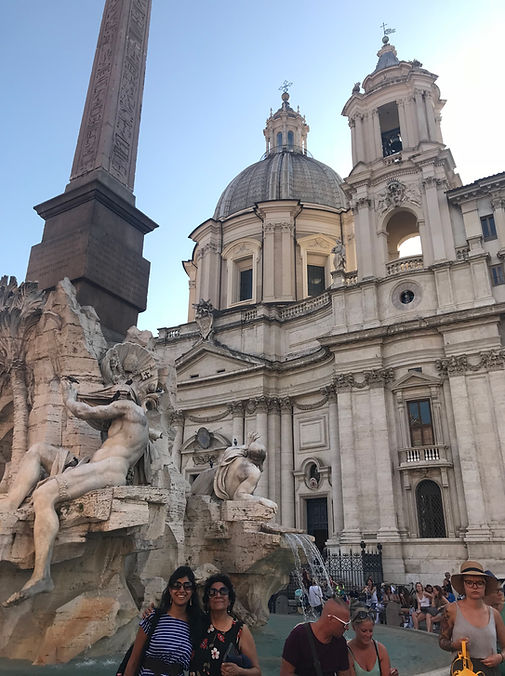
Piazza Navona
The plaza has some great art by local artists, you can hang around at the square getting your caricature sketched (which may not completely look like you but it’s worth a laugh) have delicious gelato or sip on wine. It’s a great place to experience Rome at night as well.
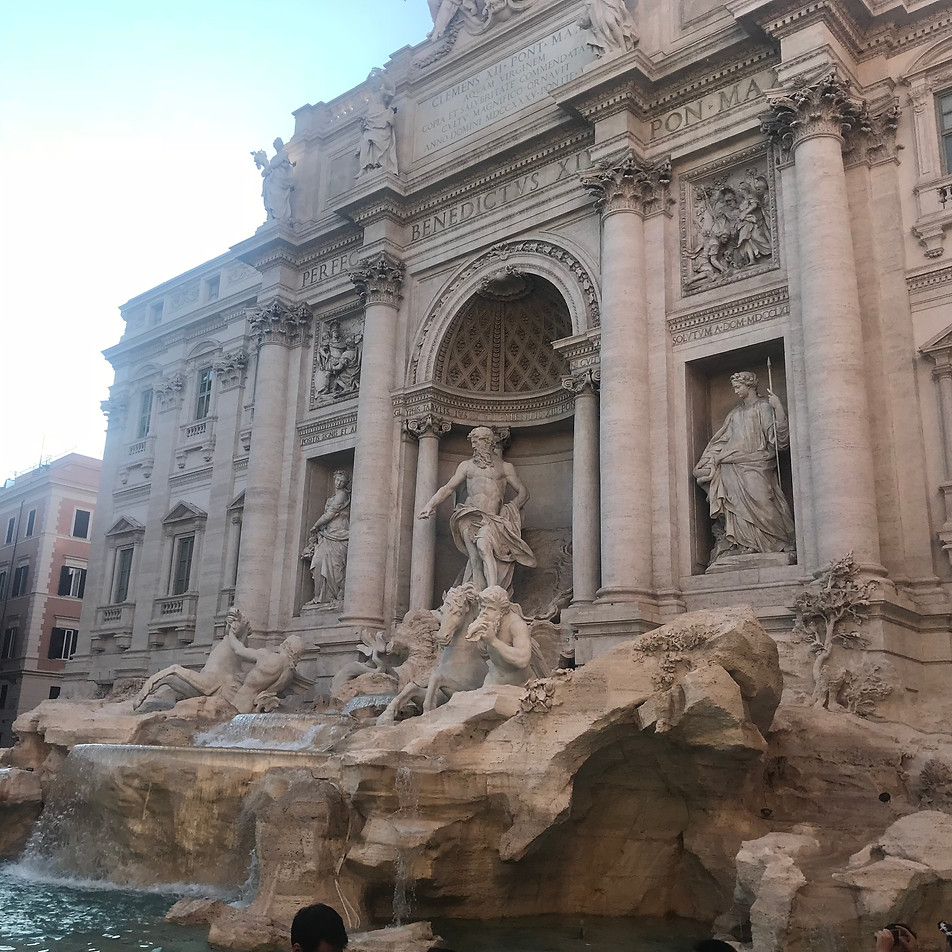
Trevi Foundation
Trevi Foundation, you see the sculpture standing in between of the dramatic structure, representing the ocean and as rumor has it Roman’s affair with water! Nicola Salvi conceived this baroque background in 1762. Water apparently gushes out from 24 spouts and the horses & wind signify the waves. People used to come here in ancient times to collect water. One of the speculations about why Romans are crazy about fountains & water is because during war the opponents would cut off the inflow from the aqueducts so the Romans wanted to ensure that in case of a siege they were completely self-sufficient. Every corner you turn, Rome doesn’t cease to amaze you with its grandeur and magnificence.
Spanish Steps, is filled with people at all times day & night, the Spanish embassy has been here for 300 years, thus, the name. Spanning 138 steps, you find yourself descending into the sinking boat fountain, one of the several manifestations of the Roman aqueducts.

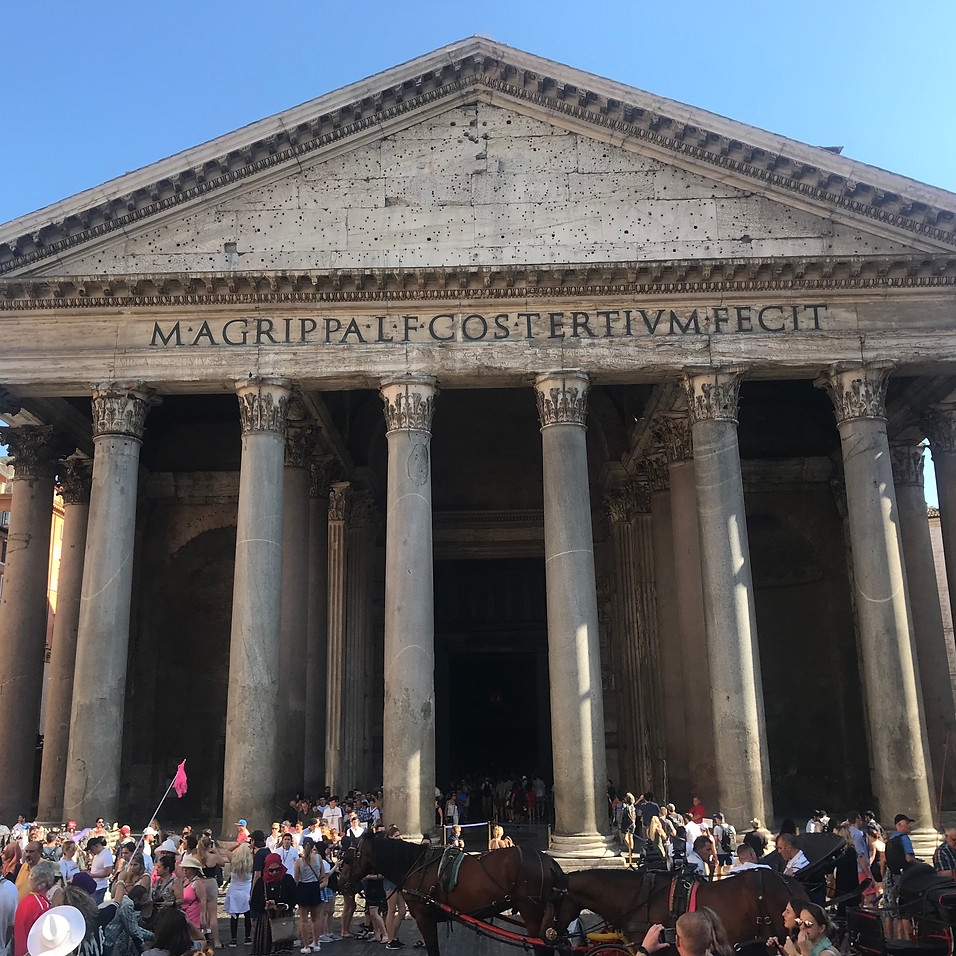
Pantheon
Pantheon, one of the most well preserved Roman monuments, has tremendous Greek influence with 16 massive columns spanning the facade of the building. It was originally built as early as 27 B.C., with pantheon translating into ‘all gods’. It was only after Christianity was established in 312 BC that it became a Christian Church, and today people get married here to seal their love. Inside there are tombs of Raphael the painter, Victor Manuel II the first King to unite Rome and his son, Umberto I both belonging to the royal Savoy family. The tomb of Umberto’s son, Victor Emmanuel III who reined for 40+ years hasn’t been honored in the Pantheon because he collaborated with Mussolini, abandoned and fled the country when the Germans arrived.
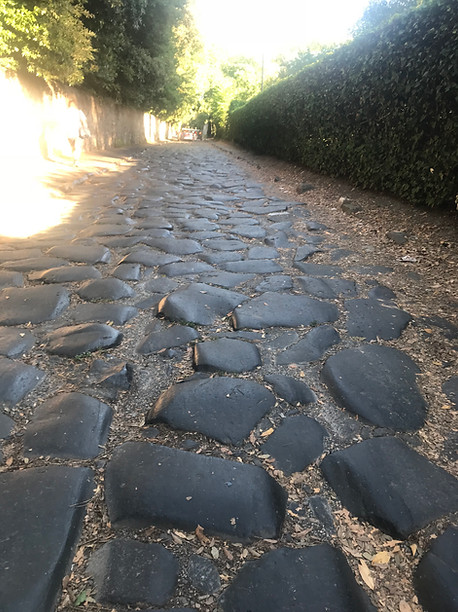
Appian Way
Appian Way
Navigating the path (it’s free): One can bike the Appian Way, take a bus/cab or enjoy the long walk. We stopped at the visitor center, from where we took a brochure that highlights all the main sites and commenced our excursion through the Catacombs of San Sebastiano & San Callisto, Circus Maxentius where the horses would race, Tomb of Cecilia Metella’s daughter-in-law of Rome’s richest man apparently, Mausoleum of Romulus considered the Son of Rome as legend goes. Stories indicate that Spartacus was crucified, along with his army on Via Appia Antica.
With some parts of the roads of the Appian Way, dating back to 2000 years ago, it’s surreal to walk on the same stones as the Ancient Romans did. Built by Appius Claudius Caecus in 312 BC, these roads were primarily used for military supplies and horses rode these massive stones with ease. Seeing cars / bikes attempting to drive across these roads today is merely amusing with all the creeks & groans.

Tomb of Cecilia Metella

Eating: We ate at a restaurant called Antica Appia and as we sat in the aesthetically maintained gardens, we enjoyed the view of Cecilia Metella’s castle. I do have to recommend, as the person who runs the restaurant proclaimed, I had the best tiramisu out here, the creamy ice cream & the moisture of the cake is what it made it so utterly delectable!

Vatican City
Vatican City
Tickets: I’d suggest booking tickets in advance as the cues stretch across for 2-3 hours. Tickets can be booked online for an extra fee. A guided/audio tour is fantastic and highly recommended for the Vatican & Sistine Chapel. The best time to visit is 8:00 AM in the morning to beat the crowd.
In case you don’t have tickets in advance, you can book a skip-the-line tour through official guides who are around in uniform outside and easy to find. We hadn’t pre-booked and even though the skip-the-line option was more expensive, it was completely worth it.

Vatican City
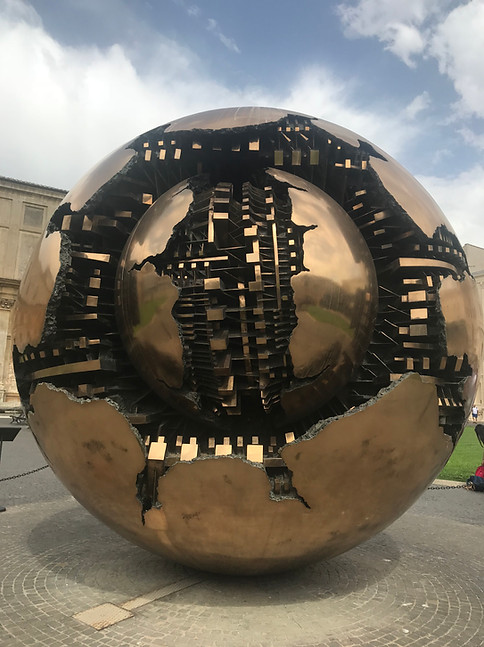
Sphere Within Sphere
Once inside, there’s an option of purchasing tickets to climb up to the cupola from where you view the Vatican from a bird-eye’s view, getting a sense of the overarching structure. Highly recommended. To enter via the staircase costs 8 euros per person. You can also buy tickets to use the elevator, which costs 10 euros per person and saves you climbing 320 steps. To go to the complete top, you can climb the remaining 165 steps.

St. Peter's Cupola
Tidbits of History: As the story goes, the pope had emperor-like power till 14th century. When Italy was unified, the pope wanted to rule over Rome but Emmanuel Victor II from the Savoy family titled the first King of Italy didn’t agree and so, the pope locked himself inside the Vatican and ever since, has never left! The biggest church in the world with the longest museums filled with a plethora of art, sculptures & riches, the Vatican elucidates in different ways the Christianity version of creation of life. The Vatican stands in St. Peter’s square, named after Saint Peter who was the very first pope and was crucified upside down, signaling respect for Christ. The Vatican is a state within a state, even viewed as the smallest country in the world, covering 100 acres of land though without representation in the UN.
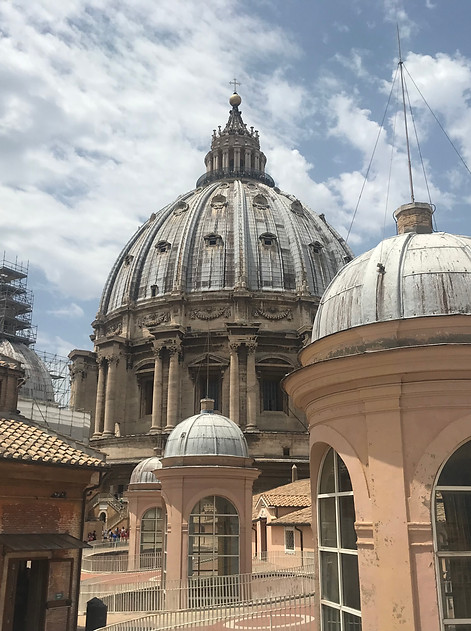
Vatican dome
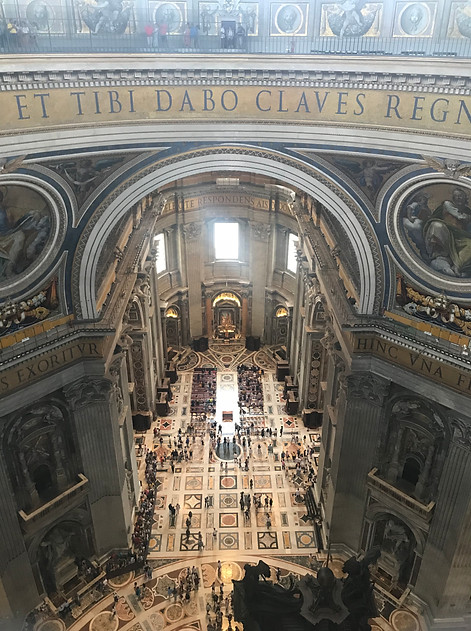
View within the dome
One of the main highlights of the Vatican is the Sistine Chapel and the story of how Michelangelo came to momentously paint the Ceiling & Last Judgment.
Michelangelo’s Last Judgment: Pope Julius II commissioned Michelangelo to paint this magnificent artwork during the splitting of the Church. The pope wanted to use art to discourage people from the “erroneous” path. Interestingly, Michelangelo was the only artist to have ever refused a pope’s summon. Soldiers were eventually sent to collect him from Florence. On arriving at the Vatican, he literally locked himself in the Sistine Chapel and took 5 years to paint the Last Judgment. Not even allowing the pope to enter, it was only when an advisor managed to make his way in, that the advisor reported back to the pope that the painting was too crowded and not good enough. It was suggested that the painting be cleaned and started afresh. This made Michelangelo very angry and he added to the lower right the darkest most ungodly figure or some say his biggest critic with a snake wrapped around him, a tail & ears as revenge. The pope gave up and allowed him to proceed. To the right is the fall of the damned, with people entering hell and to the left are the believers entering heaven. If you look carefully towards the center of the painting, Michelangelo painted himself as a ghostly figure with his skin melting indicating that he’s tired of everything that he’s being made to do. His first love was sculptures. Apparently, he was supremely bad-tempered and got into a fight with a fellow artist because of which he lived with a crooked nose.

Colosseum
Colosseum
Tickets: Cues seem to be second nature for all touristic sites in Rome. You can book tickets online in advance for the Colosseum and with these tickets enter post 2:00 PM. You can use the same ticket to enter Roman Forum, which is valid for the same or next day.

Inside the Colosseum
Tidbits of History; A New Wonder of the World. Its glorious overpowering structure is truly something to reckon with! At a height of 162 feet, it spreads across 6 acres standing tall for the last 2000 years. Under Vespasian’s rule in A.D. 72, the construction of Colosseum began, with his son Titus inaugurating it & grandson Domitian completing it by A.D. 80. The Colosseum was built where Emperor Nero’s golden palace had originally stood, but he was hated by the people because he had let Rome burn, failing to protect the city & continuing to play the fiddle during attacks. This was one-way people believed that they were re-claiming their space! Originally, a covered circular arena, each of these arches had a sculpture. It had the capacity to hold 50,000 spectators and as the audience entered they were handed a piece of pottery, which had their seat number. Wine was served in glasses that had the Gladiators name carved on them. Apparently, it was a strategy to keep the unemployed off the streets with prisoners, slaves & the poor being pushed to become gladiators! With 80 entrances, the gladiators had no idea from where & which animal would be released into the arena. Different scenes with the forests & ocean were re-created in this space for people to enjoy the spectacle. The ultimate goal of this sport was to kill and it’s unfathomable how people supported the brutal bloodshed. When Constantine declared Christianity as the official religion in 312 AD, the killings finally came to a halt. Thereafter, for a while squatters and small markets occupied the arena. Only with the pope coming into power, did the restoration of this mammoth structure begin, as a way of preserving Roma.

Colosseum
Arch of Constantine
Between the Colosseum and Palatine Hill is the Arch of Constantine built in 315 BC, which marked the legality of Christianity, with Constantine I establishing his victory over Maxentius at the Battle of Milvian Bridge. You get the best view of the arch from the second level of the Colosseum, seeing the collage of intricate designs made by previous emperors up close.

Arch of Constantine


Roman Forum
Roman Forum
The center of it all, heart of the Ancient Roman Empire, where Caesar ruled, where the victorious warriors were celebrated when they returned with their booty, where decisions were made for next conquests, where wealth was accumulated & the empire was expanded. The Roman Forum is truly a space that left me fascinated thinking about everything the walls and plaza have witnessed all those centuries ago.
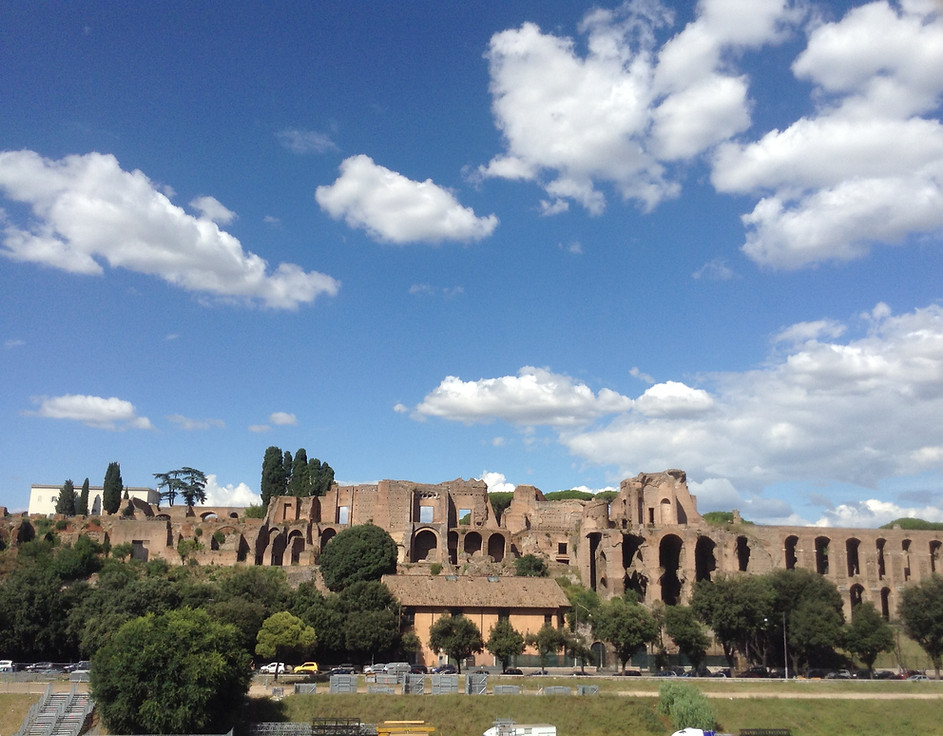
Aventine Hill
En route from the Colosseum to the Roman Forum is Palatine Hill. There are seven hills in Rome and Palatine Hill is the centermost, where excavations have revealed life from the 10th century. As you head towards Aventine Hill, beautiful ancient ruins are revealed as cars zoom by, showcasing the existence of old and the new simultaneously. There is a hole-in-a-door at Aventine Hill, which people peep through to catch a glimpse of the Vatican dome. Personally, the trip to the hole-in-the-door is not worth it, but the ruins themselves are worth visiting.
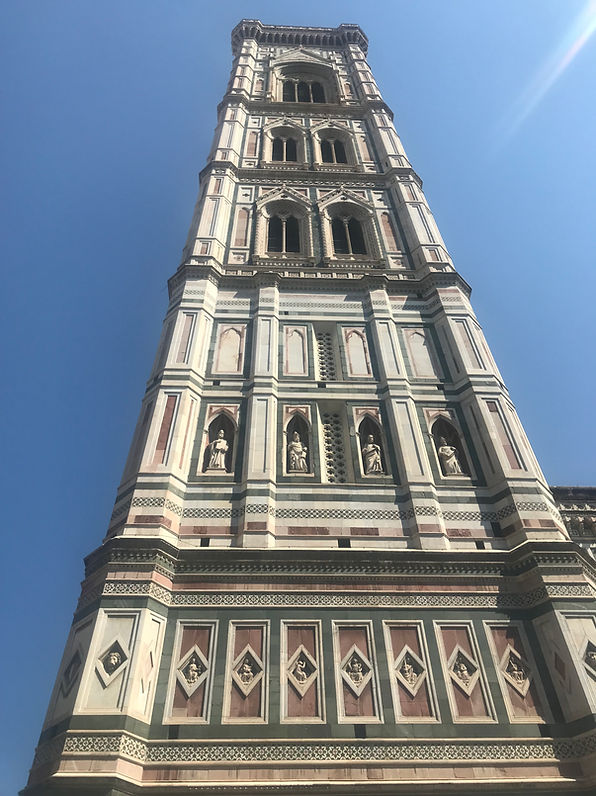
Florence
Florence
Things to explore;
-
Galleria dell’Accademia
-
Uffizi Gallery
-
Bargello Museum
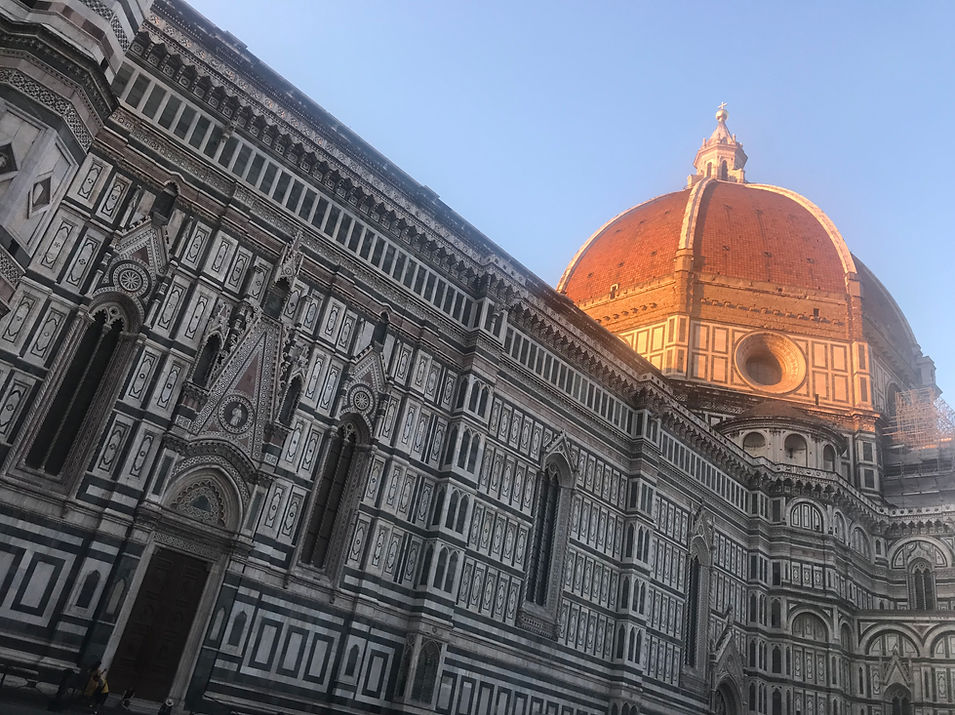
Duomo, Florence Cathedral
Galleria dell’Accademia
Tickets: You can buy tickets online in advance to avoid the long lines. There is a phenomenal difference between the general & skip-the-line tickets, so incase you haven’t purchased tickets earlier, I would suggest walking around town and finding centralized ticket kiosks where you will be able to buy tickets for all the main sites in Florence at an online rate.
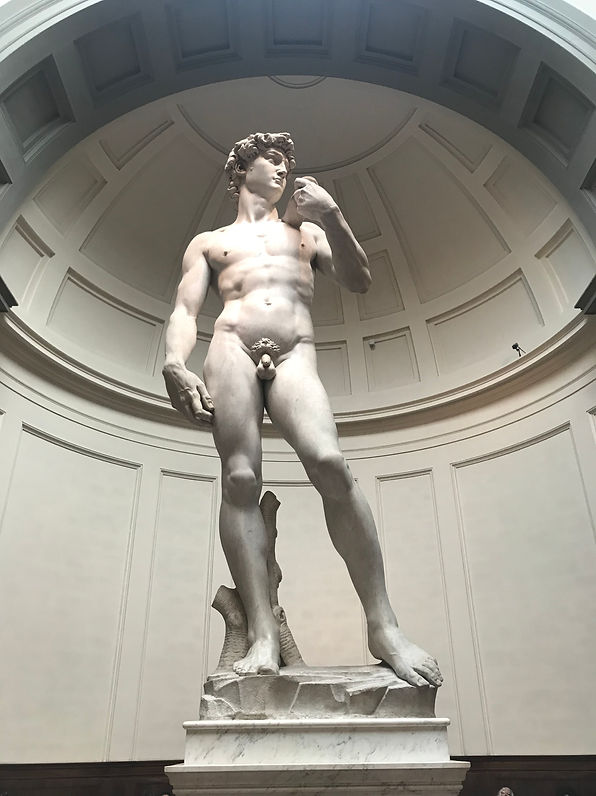
David
Within Galleria dell’Accademia stands tall Michelangelo’s David, representing the epitome of renaissance. It was in 1501, when Michelangelo was commissioned to sculpt for the top of Florence’s Cathedral, more commonly known as the Duomo. The character of David comes from the Bible and as the story goes - at the time, Israelites were surrounded by warriors and a giant named Goliath. The only person who was unafraid to fight them was a Shepard boy, David. His carved stature symbolizes Renaissance optimism, as instead of a brute he’s portrayed as a civilized thinking individual who contemplates on how to deal with the posed problem. Eventually, rather than the top of the Duomo, David stood at the entrance of Palazzo Vecchio for 350 years, after which to preserve the statue it was moved to the Galleria dell’Accademia.
Uffizi Gallery
Tickets: Book tickets in advance and spend time browsing through a museum that holds a collection from the period of Italian renaissance.

Uffizi Gallery
Bargello Museum
Tickets: There isn’t usually a queue to enter, but if you’d like to plan in advance you can book tickets online.

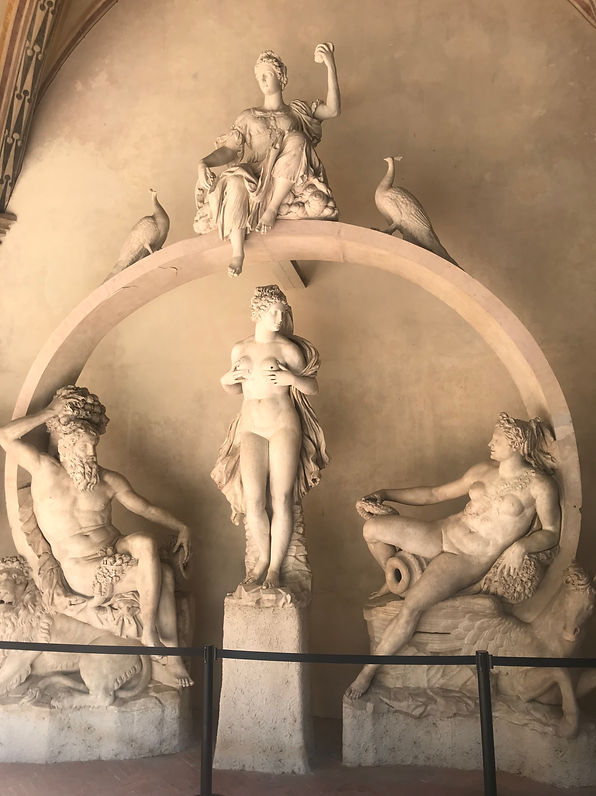
National Museum of Bargello
One of my most favorite places in Florence, I would highly recommend a visit to the National Museum of Bargello. Previously a barrack and prison is now a museum with different sculptures. On the first level, you will get to see the earlier David’s that had been sculpted, Michelangelo’s teachers and what led to the David now as we know it.
Venice
Things to explore;
-
Hop-on hop-off boat ride that takes you to all islands, a special one being, Murano Island
Known for its gondola rides, canals, waterways and beautiful architecture, Venice has a complete different vibe. I usually prefer to explore cities on my own, walking or biking through as I use maps and research places I’d like to see, but for Venice I would highly recommend the hop-on hop-off boat ride that has two parallel lines running and ensures that one sees other parts of Venice beyond the main St. Marks Square.

St. Marks Cathedral, Venice
A gondola ride seems to be a must based on all the hype that has been created through media, re-affirming the notion that you haven’t been to Venice if you haven’t taken a gondola ride. However, 80 euros for 25 minutes or 120 euros for 40 minutes isn’t fully worth it. I did take the ride and one is taken through a canal with a plethora of gondola traffic. I’d say it’s a touristic scam!

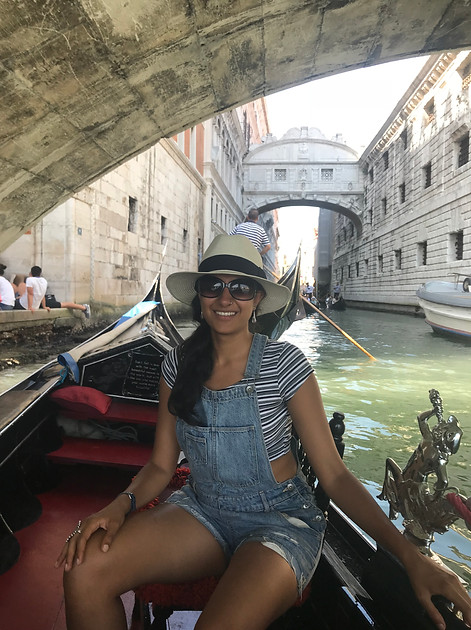
Venice
Bridge of Sighs
You can walk across the Bridge of Sighs, and experience the story of how it got the name. It connects the prison to an interrogation room and right before people were about to be imprisoned they were brought out to the bridge, shown the magnificent view of what they would most likely not see in a while, and give out loud sighs.
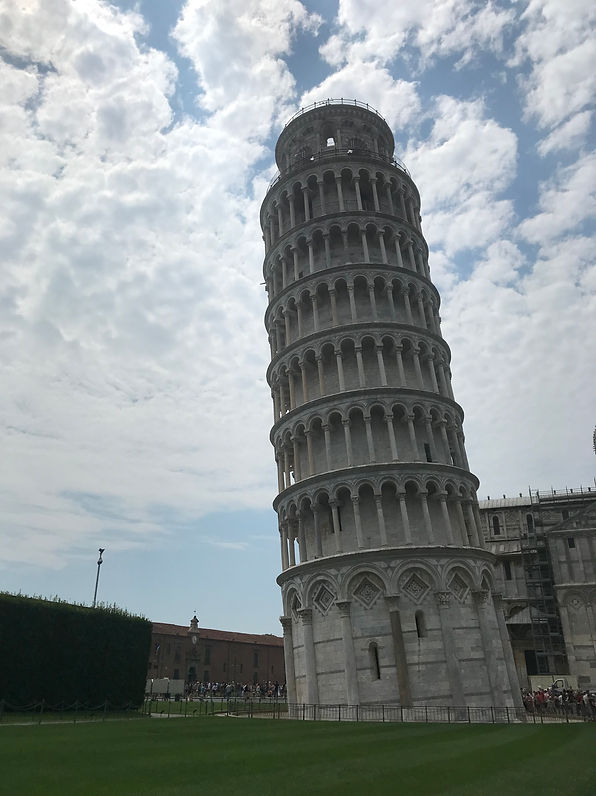
Leaning Tower of Pisa
Pisa
The Leaning Tower of Pisa is probably the only touristic reason, for which Pisa is a pit stop. A cute town with cafes and souvenir shops, I enjoyed the half-day that I spent here. However, it’s a stop that can be skipped, in my opinion. I somehow anticipated the tower to be larger than life and worth seeing, but feel I wouldn’t have missed much if I hadn’t. Sure enough it’s fascinating that a building continues to stand at an angle, with the tilt setting in the 12th century because of its inadequate foundation as it was being constructed.
In the 20th century, the Government took measures to stabilize the structure and partially fix the tilt, yet at the same time ensuring that it remained slanting so that it doesn’t loose its touristic value.

Vernazza, Cinque Terre
La Spezia
The town of La Spezia is a great base to use for visiting Cinque Terre, five small fishermen villages on the northern coastline. Staying in either one of the five villages is also possible, but I found stay in La Spezia way more reasonable with the villages literally 10 minutes away by train.

Monterosso, Cinque Terre
Cinque Terre
The villages of Vernazza, Monterosso, Corniglia, Manarola, Riomaggiore make for a great get-away spot to relax, sun oneself, take boat rides between islands, hike up trails, eat fantastic food, sip on cocktails and enjoy the beauty of the Northern coast in Italy. You can meander through the little towns, park yourself at the harbor at Vernazza, beach bum at Monterosso, hike up Corniglia and enjoy the quiet and quaint towns of Manarola & Riomaggiore.
Already excited to go back and explore the rest of the country, this time the South of Italy, stay tuned for upcoming adventures!
~Kamiya Kumar


